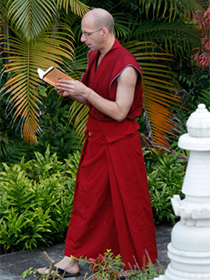- Home
- FPMT Homepage
Foundation for the Preservation of the Mahayana Tradition
The FPMT is an organization devoted to preserving and spreading Mahayana Buddhism worldwide by creating opportunities to listen, reflect, meditate, practice and actualize the unmistaken teachings of the Buddha and based on that experience spreading the Dharma to sentient beings. We provide integrated education through which people’s minds and hearts can be transformed into their highest potential for the benefit of others, inspired by an attitude of universal responsibility and service. We are committed to creating harmonious environments and helping all beings develop their full potential of infinite wisdom and compassion. Our organization is based on the Buddhist tradition of Lama Tsongkhapa of Tibet as taught to us by our founders Lama Thubten Yeshe and Lama Thubten Zopa Rinpoche.
- Willkommen
Die Stiftung zur Erhaltung der Mahayana Tradition (FPMT) ist eine Organisation, die sich weltweit für die Erhaltung und Verbreitung des Mahayana-Buddhismus einsetzt, indem sie Möglichkeiten schafft, den makellosen Lehren des Buddha zuzuhören, über sie zur reflektieren und zu meditieren und auf der Grundlage dieser Erfahrung das Dharma unter den Lebewesen zu verbreiten.
Wir bieten integrierte Schulungswege an, durch denen der Geist und das Herz der Menschen in ihr höchstes Potential verwandelt werden zum Wohl der anderen – inspiriert durch eine Haltung der universellen Verantwortung und dem Wunsch zu dienen. Wir haben uns verpflichtet, harmonische Umgebungen zu schaffen und allen Wesen zu helfen, ihr volles Potenzial unendlicher Weisheit und grenzenlosen Mitgefühls zu verwirklichen.
Unsere Organisation basiert auf der buddhistischen Tradition von Lama Tsongkhapa von Tibet, so wie sie uns von unseren Gründern Lama Thubten Yeshe und Lama Thubten Zopa Rinpoche gelehrt wird.
- Bienvenidos
La Fundación para la preservación de la tradición Mahayana (FPMT) es una organización que se dedica a preservar y difundir el budismo Mahayana en todo el mundo, creando oportunidades para escuchar, reflexionar, meditar, practicar y actualizar las enseñanzas inconfundibles de Buda y en base a esa experiencia difundir el Dharma a los seres.
Proporcionamos una educación integrada a través de la cual las mentes y los corazones de las personas se pueden transformar en su mayor potencial para el beneficio de los demás, inspirados por una actitud de responsabilidad y servicio universales. Estamos comprometidos a crear ambientes armoniosos y ayudar a todos los seres a desarrollar todo su potencial de infinita sabiduría y compasión.
Nuestra organización se basa en la tradición budista de Lama Tsongkhapa del Tíbet como nos lo enseñaron nuestros fundadores Lama Thubten Yeshe y Lama Zopa Rinpoche.
A continuación puede ver una lista de los centros y sus páginas web en su lengua preferida.
- Bienvenue
L’organisation de la FPMT a pour vocation la préservation et la diffusion du bouddhisme du mahayana dans le monde entier. Elle offre l’opportunité d’écouter, de réfléchir, de méditer, de pratiquer et de réaliser les enseignements excellents du Bouddha, pour ensuite transmettre le Dharma à tous les êtres. Nous proposons une formation intégrée grâce à laquelle le cœur et l’esprit de chacun peuvent accomplir leur potentiel le plus élevé pour le bien d’autrui, inspirés par le sens du service et une responsabilité universelle. Nous nous engageons à créer un environnement harmonieux et à aider tous les êtres à épanouir leur potentiel illimité de compassion et de sagesse. Notre organisation s’appuie sur la tradition guéloukpa de Lama Tsongkhapa du Tibet, telle qu’elle a été enseignée par nos fondateurs Lama Thoubtèn Yéshé et Lama Zopa Rinpoché.
Visitez le site de notre Editions Mahayana pour les traductions, conseils et nouvelles du Bureau international en français.
Voici une liste de centres et de leurs sites dans votre langue préférée
- Benvenuto
L’FPMT è un organizzazione il cui scopo è preservare e diffondere il Buddhismo Mahayana nel mondo, creando occasioni di ascolto, riflessione, meditazione e pratica dei perfetti insegnamenti del Buddha, al fine di attualizzare e diffondere il Dharma fra tutti gli esseri senzienti.
Offriamo un’educazione integrata, che può trasformare la mente e i cuori delle persone nel loro massimo potenziale, per il beneficio di tutti gli esseri, ispirati da un’attitudine di responsabilità universale e di servizio.
Il nostro obiettivo è quello di creare contesti armoniosi e aiutare tutti gli esseri a sviluppare in modo completo le proprie potenzialità di infinita saggezza e compassione.
La nostra organizzazione si basa sulla tradizione buddhista di Lama Tsongkhapa del Tibet, così come ci è stata insegnata dai nostri fondatori Lama Thubten Yeshe e Lama Zopa Rinpoche.
Di seguito potete trovare un elenco dei centri e dei loro siti nella lingua da voi prescelta.
- 欢迎 / 歡迎
简体中文
“护持大乘法脉基金会”( 英文简称:FPMT。全名:Foundation for the Preservation of the Mahayana Tradition) 是一个致力于护持和弘扬大乘佛法的国际佛教组织。我们提供听闻,思维,禅修,修行和实证佛陀无误教法的机会,以便让一切众生都能够享受佛法的指引和滋润。
我们全力创造和谐融洽的环境, 为人们提供解行并重的完整佛法教育,以便启发内在的环宇悲心及责任心,并开发内心所蕴藏的巨大潜能 — 无限的智慧与悲心 — 以便利益和服务一切有情。
FPMT的创办人是图腾耶喜喇嘛和喇嘛梭巴仁波切。我们所修习的是由两位上师所教导的,西藏喀巴大师的佛法传承。
繁體中文
護持大乘法脈基金會”( 英文簡稱:FPMT。全名:Found
ation for the Preservation of the Mahayana Tradition ) 是一個致力於護持和弘揚大乘佛法的國際佛教組織。我們提供聽聞, 思維,禪修,修行和實證佛陀無誤教法的機會,以便讓一切眾生都能 夠享受佛法的指引和滋潤。 我們全力創造和諧融洽的環境,
為人們提供解行並重的完整佛法教育,以便啟發內在的環宇悲心及責 任心,並開發內心所蘊藏的巨大潛能 — 無限的智慧與悲心 – – 以便利益和服務一切有情。 FPMT的創辦人是圖騰耶喜喇嘛和喇嘛梭巴仁波切。
我們所修習的是由兩位上師所教導的,西藏喀巴大師的佛法傳承。 察看道场信息:
- FPMT Homepage
- News/Media
-
- Study & Practice
-
-
- About FPMT Education Services
- Latest News
- Programs
- New to Buddhism?
- Buddhist Mind Science: Activating Your Potential
- Heart Advice for Death and Dying
- Discovering Buddhism
- Living in the Path
- Exploring Buddhism
- FPMT Basic Program
- FPMT Masters Program
- FPMT In-Depth Meditation Training
- Maitripa College
- Lotsawa Rinchen Zangpo Translator Program
- Universal Education for Compassion & Wisdom
- Online Learning Center
-
- Prayers & Practice Materials
- Overview of Prayers & Practices
- Full Catalogue of Prayers & Practice Materials
- Explore Popular Topics
- Benefiting Animals
- Chenrezig Resources
- Death & Dying Resources
- Lama Chopa (Guru Puja)
- Lama Zopa Rinpoche: Compendium of Precious Instructions
- Lama Zopa Rinpoche: Life Practice Advice
- Lama Zopa Rinpoche Practice Series
- Lamrim Resources
- Mantras
- Prayer Book Updates
- Purification Practices
- Sutras
- Thought Transformation (Lojong)
- Audio Materials
- Dharma Dates - Tibetan Calendar
- Translation Services
- Publishing Services
- Ways to Offer Support
- Prayers & Practice Materials
-
- Teachings and Advice
- Find Teachings and Advice
- Lama Zopa Rinpoche Advice Page
- Lama Zopa Rinpoche: Compendium of Precious Instructions
- Lama Zopa Rinpoche Video Teachings
- ༧སྐྱབས་རྗེ་བཟོད་པ་རིན་པོ་ཆེ་མཆོག་ནས་སྩལ་བའི་བཀའ་སློབ་བརྙན་འཕྲིན།
- Podcasts
- Lama Yeshe Wisdom Archive
- Buddhism FAQ
- Dharma for Young People
- Resources on Holy Objects
- Teachings and Advice
-
-
*If a menu item has a submenu clicking once will expand the menu clicking twice will open the page.
-
-
- Centers
-
- Teachers
-
- Projects
-
-
-
-
*If a menu item has a submenu clicking once will expand the menu clicking twice will open the page.
-
-
- FPMT
-
-
-
-
-
Over and over again our experiences prove that it is our mental outlook that is fundamentally responsible for whether we are successful or unsuccessful, healthy or ill, attractive or ugly, happy or depressed.
Lama Thubten Yeshe
-
-
-
- Shop
-
-
-
The Foundation Store is FPMT’s online shop and features a vast selection of Buddhist study and practice materials written or recommended by our lineage gurus. These items include homestudy programs, prayers and practices in PDF or eBook format, materials for children, and other resources to support practitioners.
Items displayed in the shop are made available for Dharma practice and educational purposes, and never for the purpose of profiting from their sale. Please read FPMT Foundation Store Policy Regarding Dharma Items for more information.
-
-
Life in Sera Je Monastery
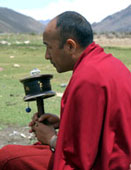
Introduction
Monks in Sera range in age from 7 to 90. Anyone who wishes to join Sera Je Monastery is accepted only after investigating their background according to the Vinaya, such as whether they have their parents’ permission to be ordained, have reached at least the age of 7 and so on. Having met those requirements, the Monastery accepts anyone regardless of their race, or social or family background; nobody is turned away.
Therefore it is easy to see why the number of monks is increasing by hundreds every year. Each year, at least a few hundred come from Tibet and others from all over the world. At the moment, Sera Je has slightly more than three thousands monks.
The Sera Je Food Fund
Before Lama Zopa Rinpoche founded the “Sera Je Food Fund” many years ago, all the monks had to take care of their own food since the Monastery could not afford to provide even basic necessities such as food, clothing or books. Only a few monks were fortunate enough to get support from their parents, relatives or sponsors. Most of the monks were Tibetan refugees and did not have any relatives in India. Even if they had relatives in India, they were too poor to be able to give any support. Many of them did not have money to buy even milk or tea. Some of them would eat very little. As a result, many monks either fell sick with T.B. or suffered from gastric problems. This could lead to stomach ulcers followed by stomach cancer if not treated early. Many monks died due to stomach cancer.
Because of these difficulties, many monks left the Monastery. Young men were reluctant to join the Monastery when they heard about these hardships; even though from the depths of their hearts they wanted to study.
The living condition of the monks has improved tremendously after the Food Fund was set up, although many monks still suffer from gastric problems. The Food Fund enables the Monastery now to provide simple lunch and dinner for all the monks and they can finally focus their energy on their studies.
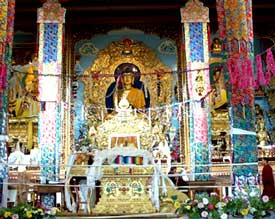
Studies in the Monastery
Within Sera Je Monastery there are two divisions for study. For young monks of age of 7 to 18, they attend the Sera Je School which provides general modern education with subjects such as English, Mathematics, Science and Arts in addition to Tibetan Grammar, Buddhist Philosophy etc. At the moment there are around five to six hundred students in the school from grade 1-12.
Once they have graduated from the school, they proceed to join the Monastery’s main University to study Buddhist Philosophy in more detail. The system of study in Sera Je is similar to that of Nalanda Monastery in ancient India. Nalanda was the largest Monastery and university in India for the study of Buddhism during its peak. The Monastery produced many great masters and practitioners such as Nagarjuna, Shantideva and Dharmakirti, to mention just a few. This system involves debating in order to understand the texts correctly, to dispel any misconceptions or misunderstanding of the subject and particularly to help to understand their essential points.
The Five Great Scriptures studied in the Monastic University
Five Great Scriptures or texts are studied in the Monastery. They are :(1) Abhidharma Kosha by Basubandu, (2) Parmanavartika by Dharmakriti, (3) Abhisamaya Alamkara by Maitreya Buddha, (4) Madhyamika by Chandrakridi, (5) Vinaya (Root Sutra) by Buddha Shakyamuni and also commentaries by other Indian and Tibetan masters.
“Abhidharma Kosha “ has eight chapters. The first chapter explains about the elements; the Second chapter is about the faculties; the Third chapter is on the Universe and sentient beings dwelling in it; the Fourth chapter is on Karma; the Fifth is about afflictive emotions; the Sixth is on the Buddhist paths and persons engaging in those paths; the Seventh talks about Exalted Wisdom and Buddha’s qualities; the final Eighth chapter explains about the concentrations and so on. All these explanations are according to the Vaibashika system (one of the four main schools of Buddhist Philosophy).
“Parmanavartika” has four chapters. It explains mainly about mind and its functions, past and future lives, valid and invalid cognitions/persons, direct and inferential cognitions, the Four Noble Truths, love, compassion, the basis, the path and its results according to the Sautrantika (Sutra school) and Cittamatra (Mind only school), but mainly acccording to the Cittamatra School.
“Abhisamaya Alamkara” has eight chapters. It explains about Mind and its functions, valid and invalid cognitions, direct and inferential cognitions, the Four Noble Truths, love, compassion, Bodhicitta, the Six Perfections, Five paths, Ten Bhumis (grounds), qualities of the Buddhas and spiritual teachers etc. In brief it is about the Basis which is the ” two truths”, Path which is the “method and wisdom”, Result which is the “two kayas”, emphasizing more on the method side. This scripture explains mainly according to the Svatantrika Madhyamika (Autonomous Middle way school).
“Madhyamika” has ten chapters. It explains about love, compassion, Bodhicitta, Two and Four Truths, Five paths, Ten bhumis, Six perfections and the qualities of Bodhisattavas and Buddhas in great detail. Particularly about Emptiness, Interdependence as well as the wisdom realizing emptiness in every detail. In summary, it is about the Basis which is the “two truths”, Path which is the “method and wisdom” and Result which is the “two kayas”, emphasizing more on the wisdom side. This scripture explains mainly according to the Prasangika Madhyamik (Consequences Middle way School).
“Vinaya” explains about all the eight Pratimoksha vows, Yarne ( monk’s summer retreat) Gaye ( break after the retreat ) and Sojong ( restoring and purifying ceremony). All the things that ordained ones should avoid and things that one should practice.
Number of years to complete the studies
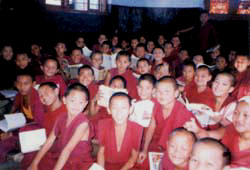
It takes at least 16 years of intensive studies to complete these five great scriptures. There are 13 grades within the University. The first seven grades require a year of study in each grade. 2 to 3 years for the eighth grade, 3 to 4 years for the ninth grade, 2 to 4 years for the tenth grade and eleventh grades and several years for the final twelfth and thirteenth grades.
During the first seven grades, the monks study various preparation texts for the major scriptures such as the three collected topics: “Lorig”, “Tarig” and parts of the “Abhisamaya Alamkara” and “Parmanavartika”.
During the eighth grade, the monks study the complete “Abhisamaya Alamkara” in detail.
During the ninth grade, they study “Madhyamika”. During the tenth grade, they study ” Vinaya”. During the eleventh grade, they study “Abhidharmakosha”. During the twelfth and thirteenth grades, they review all the scriptures and particularly “Vinaya” and “Abhidharmakosha” again and again.
The studying of the “Parmanavirtika” is from grade 3 till 13 for two months every year.
Once the monks have completed their studies and pass the various examinations, they receive their “Geshe” degree, which is the equivalent of a PHD in Buddhist Philosophy.
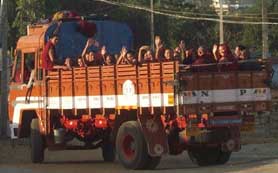
Daily Schedule
A typical daily schedule of a monk in Sera Je:
5.00 am Wake up and wash.
5.30 am Morning prayers. Breakfast will be served during prayer session if there is any sponsor.
7.30 to 9.00 am Memorizing prayers and scriptures.
9.00 to 10.00 am Debating class.
10.00 to 10.30 am Chanting Sutras and reciting prayers as preliminary practices as well as to eliminate obstacles toward one’s study and practices.
10.30 to 11.30 am Debating class.
11.30 to 12.30 pm Lunch with prayers and dedications for sponsors and all sentient beings.
12.30 to 1.00 pm Break time.
1.00 to 2.00 pm Receiving teachings from teachers.
2.00 to 4.00 pm Homework. Reading, reflecting and discussing on the subjects, covered particularly by the teacher on that day.
4.00 to 5.00 pm Receiving teaching from teachers.
5.00 to 5.30 pm Dinner with prayers.
5.30 to 6.00 pm Break time.
6.00 to 7.00 pm Evening debating class.
7.00 to 8.30/9.00 pm Prayers and meditation. Reciting Heart Sutra, 21 Tara praises many times and reciting many other prayers as preliminary practices and to eliminate obstacles toward one’s study and practices.
9.00 to 10/11.00 pm Debating class (Some of the monks will continue until midnight or 1 am).
10/11.00 to 12.00 mn Reciting the prayers and scriptures which have been memorized so that one does not forget.
12.00mn Bed time but many monks will study till 1 or 2 am.
The schedule changes a little during different times of year. For example, in December, there will be a week of prayers and meditation which start at 2.30 in the morning and go till 9.30 in the evening. There will be short debating classes within that period and many monks will be studying after 9.30pm. The schedule also changes during the Monlam Chenmo (The Great Prayers Festival) or during the Geshe graduation ceremonies etc.
The Geshes
Four levels of Geshe Degree are awarded after a monk has completed his studies in the Monastery: Lharampa, Tsogrampa, Rigrampa and Lingse. There are some monks who, even though they have the knowledge and qualifications to become a Lharampa Geshe (the highest level), choose to get one of the lower level Geshe degrees or even sometimes decide not to get a Geshe degree for various reasons. After obtaining a Geshe Degree, a monk will be called a Geshe.
Nowadays, Sera Je produces around 10 Lharampas, 6 to 8 Tsogrampas, Rigrampas and Lingses, a total of around 34 Geshes every year.
Most of the Geshes will then join either the Gyume or Gyuto Tantric College for at least one year. At these Tantric Colleges, they study different texts on Vajrayana or Tantra such as the Tantric Grounds and Paths, commentaries on the generation and completion stages on various Tantric Buddha practices, focusing mainly on the Guhyasamaja, Chakrasamvara and Yamantaka. They also learn about all the rituals, including the drawing of Mandalas and so on. The schedule there is very tight and long, practices or pujas will sometimes last for 12 to 16 hours a day. Sometimes, the pujas start around 2.30 in early morning and last until 6 or 8 in the evening with only half an hour break for lunch and dinner and about 10 minutes break in between sessions.
After completing their studies in one of the Tantric Colleges, some Geshes will return to Sera Monastery to become teachers there. The teachers teach the monks for 5 to 8 hours a day, 6 days a week. No salary or pocket money is provided to these teachers. Occasionally some students who get extra money would make an offering to their teachers. But as most of the monks are poor, it is usually the teachers who help the students instead. Therefore it is clear that the teachers teach purely out of compassion without any expectations from their students.
A few years ago, Lama Zopa Rinpoche started a fund called the Lama Tsongkhapa Teachers Fund to support these kind teachers in the various monasteries of India and Nepal. The fund has been able to provide a small amount of money as an offering for their kindness in educating the young monks.
Many Geshes are invited to teach in Buddhist organizations around the world. Currently, in FPMT centers alone, there are over 40 resident Geshes and Lamas. There are also Geshes being requested to teach in monasteries, schools or universities in Tibetan settlements in countries such as Nepal, India, Bhutan, and Tibet.
Some Geshes may decide to remain in their monasteries such as Sera Je, to offer their services in different departments like the Health Care Committee, Education Committee, and Ritual Practice Committee etc. A few of them will eventually be appointed as the abbot of their monasteries or another Monastery.
Then there are also some Geshes who do short or long retreats (such as the 3 year retreat or even for the rest of their life) in the Monastery or in the mountains.
Ganden Tripa
A qualified Geshe may also eventually become the Ganden Tripa (Head of the Gelug lineage in Tibetan Buddhism). To become the Ganden Tripa, one needs to have obtained the highest Lharampa Geshe degree, then one must enter into one of the 2 Tantric Colleges. After studying the tantric texts for at least one year, one needs to take the exams. Having completed the exams, one will at a later stage be appointed as the disciplinarian of the college. During that time, the disciplinarian has to recite from memory the whole commentary of the root tantra text, and at times serve as the ritual master as well. Having completed his term as the disciplinarian, one then naturally becomes a candidate for the Lama Utzse -the head lama of ritual ceremonies. The post is appointed by His Holiness the Dalai Lama from a list of candidates provided by the Monastery, which is the same procedure for the appointment of the abbots of Sera, Drepung, Ganden and various monasteries. The appointed Lama Utse will serve his 3-year term followed by 3 more years as the abbot of the Tantric College.
Every ex-abbot of Gyume & Gyuto Tantric colleges becomes in line to be appointed as the Jangtse or Shartse Choje respectively. The Jangtse and Shartse Choje alternate to finally become the Ganden Tripa. There is a saying in the monasteries, ” If a mother’s child has the knowledge/wisdom, then there is no ownership to the Ganden’s throne” which means that any ordinary monk who has the intelligence and makes the effort could eventually become the Ganden Tripa. However, the need to have a great amount of merit is also emphasized in order to become a Ganden Tripa. Therefore, both merit and knowledge is required to accomplish this goal.
How the Lam Rim (Graduated Path to Enlightenment) is integrated in the Monastery
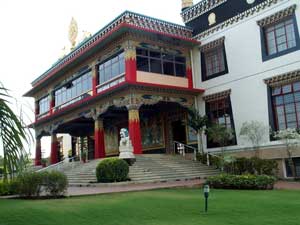
In terms of integrating Lam Rim in the studies and practices at Sera Je Monastery:
Preliminary Practices
When a monk first joins the Monastery, the rule is that one has to attend all the classes, pujas and all other practices without missing any of them for at least three years for purification and accumulating merits. Also the monks have to serve the Sangha (community of monks) by helping in the kitchen, the canteens, fields etc to accumulate merit all year round while they are studying, particularly during first three years.
When it’s their turn to serve the meals or tea to the Sangha, they practice doing them very respectfully, with the motivation that one is making these offerings to the monks oneself.
When they clean the prayer halls and the Monastery’s compounds, they do it with the motivation to purify and accumulate merits. The teachers, abbot and disciplinarian always remind the monks about the importance of purification and accumulating merits through services to the Monastery and Sangha as well as the recitation of prayers, great scriptures and sutras etc. There is a saying, “for one handful of study or practice, one needs two handfuls of prayers and recitation of scriptures and sutra as purification and accumulation of merits”. That is why there are so many long sessions of prayers, scriptures and sutra recitations every day.
Each day, during the recitation sessions between the debating lessons, for about 2 hours, they recite the Heart Sutra more than 7 times, the first time very slowly to meditate on the meaning, faster for the second and third time and even faster for the last four times. Praises to 21 Taras are also recited more then 21 times for purification, White Umbrella, half a rosary of Snow Lion Face Dakini’s mantra, Three Long Life Deity’s mantras, as well as many other prayers and mantras for the accumulation of merits. The “Kangyur” and ” Tengyur” texts are also read. In addition, there are prayers and pujas every morning and many other pujas and prayers requested by sponsors. By the time monks finish their studies, they would have recited the Heart Sutra more then 40 thousand times, 21 Taras Praises more than 11 hundred thousand times, the “Kangyur” and “Tengyur” many times plus a few hundred thousand of Snow Lion Face Dakini and Three Long Life Deities’ mantras and thousands of other prayers and mantras. Not to mention those done individually at home or when requested by sponsors. Many monks also individually do the Vajrasattava retreat, 100 thousand prostrations, 100 thousand mandala offerings and many other preliminary practices.
Guru Devotion
When a new monk joins the Monastery, he would be under the care of one senior monk who then recommends a list of teachers he thinks best for the new monk. However, it is up to the monk to decide who he wants to take as his teacher through thorough investigation before attending any teachings from the teacher. Once he has decided, he would request that teacher to accept him as his disciple and teach him. Even if it is only for a month, the disciple would practice seriously devoting to his teacher through thought and action, regardless of whether he has received any initiation from the teacher. The monks would investigate even more before they receive any initiations from any lamas or teachers.
Meditation
Although there are many monks who do silent meditation in their own room, there is no silent group meditation with all the monks together. Instead, the whole system of the studies emphasizes analytical meditation. The monks receive teachings, read, memorize, reflect, discuss and debate on whatever subject one is studying at that time. For example, analyzing a specific topic like “Death and Impermanence” through many different reasonings or logic. There are many stories about how many Geshes, lamas and monks developed realizations while they were debating or studying.
Small Scope
The monks study the precious human rebirth, death and impermanence, the three lower realms and refuge in mainly the first and second chapters of “Pamanavartika”, in the first chapter of “Abhisamaya Alamkara” and much more details about the lower realms in “Abhidharmakosha”.
Medium Scope
The monks study, debate and meditate about the law of Karma, the nature of Samsara, Nirvana, delusions and their antidotes, two and four Noble Truths and particularly the Truth of the Path in great detail under the first and second chapter of “Parmanavartika” and under the first four chapters in “Abhisamaya Alamkara”. Karma, delusions and their antidotes are studied in more detail under “Abhidharma Kosha”. The Three Higher Trainings are covered in ” Abhisamaya Alamkara” and “Madhyamika” with greater detail on the Training of Higher Morality in “Vinaya”.
Great Scope
Topics within the Great Scope of the Lam Rim such as Love, Compassion, Bodhicitta, Buddha nature, Emptiness and the Six Perfections are covered in detail in “Abhisamaya Alamkara” , “Parmanavartika” and “Madhyamika.”. The Six Perfections are covered in greater detail under the small and great “Salam”( ground and path) section in the “Abhisamaya Alamkara” and the first six chapters of “Madhyamika”.
Lam Rim Teachings
Many high lamas including His Holiness the Dalai Lama also frequently give teachings on different Lam Rim texts at Sera, Drepung, Ganden and other monasteries in South India which most of the monks attend. Many monks also attend the Lam Rim and other teachings given by His Holiness during the annual Losar Teachings in Dharamsala. In addition, many monks also receive Lam Rim teachings from their individual teachers in the Monastery so that they can read, reflect, discuss and meditate on the various topics.
Retreats
During Losar or summer vacations, many monks do retreats from a week to two months’ long in their Monastery. Recently, all the Sera Je monks have also been doing a group Hayagriva retreat together for about 2 weeks each year.
So it is clear that studies at these Great Monasteries are not just intellectual like any ordinary school but rather they are a combination of intellectual and experiential studies through various meditations, purification and accumulation.
- Tagged: fpmt projects
- Home
- News/Media
- Study & Practice
- About FPMT Education Services
- Latest News
- Programs
- New to Buddhism?
- Buddhist Mind Science: Activating Your Potential
- Heart Advice for Death and Dying
- Discovering Buddhism
- Living in the Path
- Exploring Buddhism
- FPMT Basic Program
- FPMT Masters Program
- FPMT In-Depth Meditation Training
- Maitripa College
- Lotsawa Rinchen Zangpo Translator Program
- Universal Education for Compassion & Wisdom
- Online Learning Center
- Prayers & Practice Materials
- Overview of Prayers & Practices
- Full Catalogue of Prayers & Practice Materials
- Explore Popular Topics
- Benefiting Animals
- Chenrezig Resources
- Death & Dying Resources
- Lama Chopa (Guru Puja)
- Lama Zopa Rinpoche: Compendium of Precious Instructions
- Lama Zopa Rinpoche: Life Practice Advice
- Lama Zopa Rinpoche Practice Series
- Lamrim Resources
- Mantras
- Prayer Book Updates
- Purification Practices
- Sutras
- Thought Transformation (Lojong)
- Audio Materials
- Dharma Dates – Tibetan Calendar
- Translation Services
- Publishing Services
- Teachings and Advice
- Find Teachings and Advice
- Lama Zopa Rinpoche Advice Page
- Lama Zopa Rinpoche: Compendium of Precious Instructions
- Lama Zopa Rinpoche Video Teachings
- ༧སྐྱབས་རྗེ་བཟོད་པ་རིན་པོ་ཆེ་མཆོག་ནས་སྩལ་བའི་བཀའ་སློབ་བརྙན་འཕྲིན།
- Podcasts
- Lama Yeshe Wisdom Archive
- Buddhism FAQ
- Dharma for Young People
- Resources on Holy Objects
- Ways to Offer Support
- Centers
- Affiliates Area
- Teachers
- Projects
- Charitable Projects
- Make a Donation
- Applying for Grants
- News about Projects
- Other Projects within FPMT
- Support International Office
- Projects Photo Galleries
- Give Where Most Needed
- FPMT
- Shop
Translate*
*powered by Google TranslateTranslation of pages on fpmt.org is performed by Google Translate, a third party service which FPMT has no control over. The service provides automated computer translations that are only an approximation of the websites' original content. The translations should not be considered exact and only used as a rough guide.If you know the psychological nature of your own mind, depression is spontaneously dispelled; instead of being enemies and strangers, all living beings become your friends. The narrow mind rejects; wisdom accepts. Check your own mind to see whether or not this is true.







